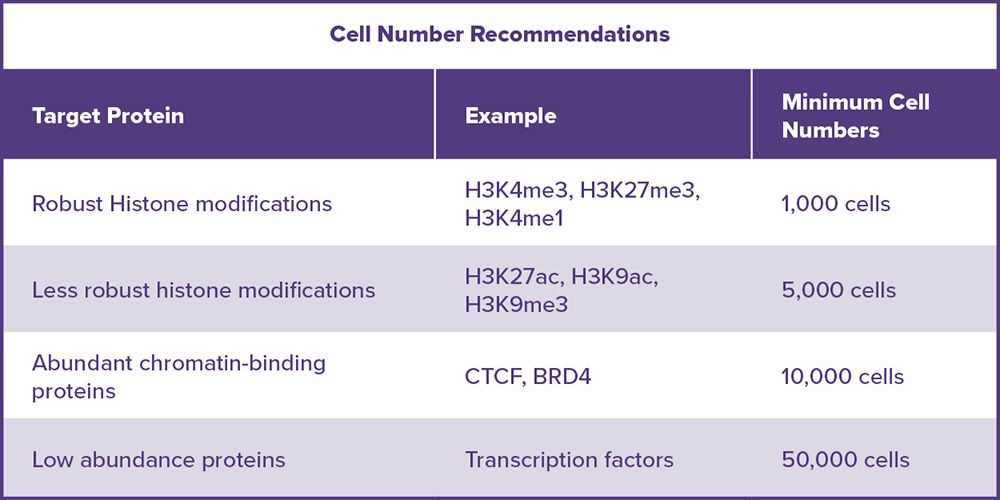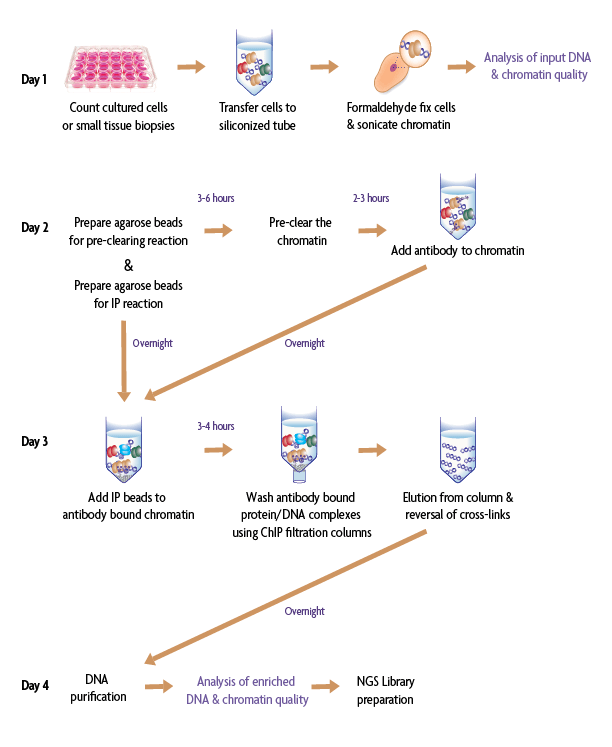Low Cell ChIP Overview
Active Motif's Low Cell ChIP Kit provides a complete ChIP workflow for chromatin preparation and immunoprecipitation from limited amounts of cells or small tissue biopsies. To see how these features compare to the other ChIP kits we offer, see our ChIP Kit Selection Guide.
The assay is robust enough to work with both high abundance histone modifications and low abundance transcription factor proteins. ChIP-Seq is a method that has traditionally required using millions of cells per immunoprecipitation reaction to generate genome-wide profiles for histone modifications or transcription factor binding. The Low Cell ChIP Kit not only reduces sample input requirements, but it also resolves poor signal-to-noise issues often associated with low cell ChIP.
Save 20% on ChIP Kits & 25% on ChIP-Validated Antibodies. Learn More
Related Products:
- DNA Library Prep Kit for Illumina®: Dual Index NGS Kit for ChIP-Seq, CUT&RUN, and ds methylated DNA assays
Low Cell ChIP Highlights:
- Reproducible ChIP for histone modifications or transcription factors from as few as 1,000 cells
- Blocking reagents and an optimized protocol improve signal-to-noise ratio for better peak calling and lower background
- The Low Cell ChIP DNA fragments are double-stranded and should work with any commercial DNA library preparation kit designed for sub-nanogram levels of DNA
The Low Cell ChIP Kit contains enough reagents to perform 16 ChIP reactions. Some of the included ChIP buffers, blockers, and protein G capture reagents may also be purchased separately.
First Time Using the Low Cell ChIP Kit?
Ensure your success with the Low Cell Optimization Module!
The Low Cell ChIP Optimization Module allows researchers to monitor the success of each critical step in the Low Cell ChIP protocol and optimize the experiments before using their valuable samples. This optimization module also enables scientists to evaluate the quality of chromatin preparations from low cell numbers to ensure best results in ChIP assays with low cell numbers.
Low Cell ChIP Contents & Storage
Please note that the Low Cell ChIP Kits are shipped on dry ice and contains reagents with multiple storage temperatures inside. All components can be stored at -20°C prior to first use, then we recommend storing each component at the temperatures indicated below. All reagents are guaranteed stable for 6 months from date of receipt when stored properly. Each kit includes the following components:
Reagents for Low Cell ChIP Kit
- 10X PBS; Store at -20°C
- Proteinase K (10 µg/µl); Store at -20°C
- Blocker; Store at -20°C
- Blocking Reagent AM1; Store at -20°C
- BSA; Store at -20°C
- 100 mM PMSF; Store at -20°C
- Protease Inhibitor Cocktail (PIC); Store at -20°C
- Carrier; Store at -20°C
- Fixation Buffer; Store at 4°C
- Protein G Agarose beads; Store at 4°C
- TE, pH 8.0; Store at RT
- 5 M NaCl; Store at RT
- Stop Solution; Store at RT
- ChIP Filtration Columns; Store at RT
- ChIP Buffer; Store at RT
- Wash Buffer AM1; Store at RT
- Elution Buffer AM4; Store at RT
- LiCl Buffer; Store at RT
- 1.7 ml siliconized tubes; Store at RT
Low Cell ChIP Data
What is Low Cell Number?
With the Low Cell ChIP Kit, researchers can perform ChIP assays on samples with limited cell numbers that were previously incompatible with ChIP. The kit is ideal if working with limited sample amounts, hard to culture cell lines, or small tissue biopsies.
The recommended cell number listed below is the amount of cells that will be used for each chromatin preparation. The entire chromatin sample is then used in a single immunoprecipitation reaction. This differs from other ChIP assays where chromatin must be prepared from larger cell numbers and then the chromatin is diluted for use in the immunoprecipitation.
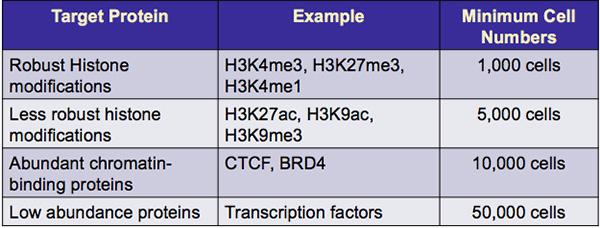
Table 1: Minimum recommended cell numbers for use with Low Cell ChIP Kit. Minimum cell numbers suggested are based on target protein abundance and antibody affinity.
Other factors that will influence the recommended cell number include cell type, abundance of target protein, and the quality of the ChIP-Seq antibody. Below are some validated antibodies from Active Motif for use with the Low Cell ChIP Kit.
| Protein Target | Active Motif Catalog Number | Cell Type Tested |
|---|---|---|
| H3K4me3 | 39159 | MDA-MB-468; GM12878 |
| H3K9ac | 39918 | GM12878 |
| H3K9me3 | 39161 | GM12878 |
| H3K27ac | 39133 | HepG2 |
| H3K27me3 | 39155 | MDA-MB-468 |
| CTCF | 61311 | MDA-MB-468 |
| BRD4 | 91301 | MDA-MB-468 |
Table 2: Active Motif's Low Cell ChIP validated antibodies.
Active Motif's Low Cell ChIP Kit was used to generate ChIP-Seq data from 10,000 MDA-MB-468 cells using an antibody directed against bromodomain-containing 4 (BRD4) protein, or 5,000 GM12878 cells using antibodies directed against histone H3K27ac or histone H3K27me3. Following ChIP, Illumina-compatible sequencing libraries were prepared and sequenced using the NextSeq 500. Results show high quality ChIP-Seq peaks can be obtainined using as few as 5,000 cells for both active and repressive histone modifications and as few as 10,000 cells for BRD4. Peaks were compared to ENCODE data sets using 20 million cells.
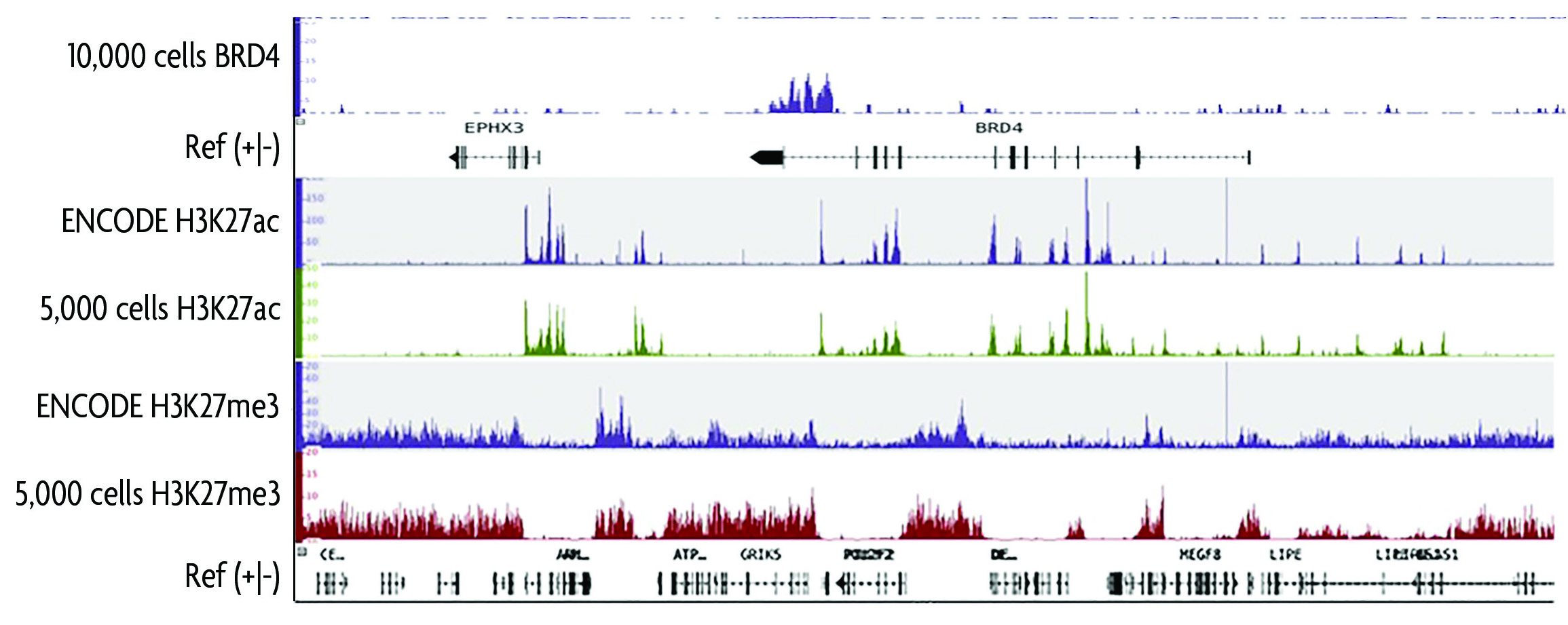
Figure 1: Low Cell ChIP peaks for BRD4, H3K27ac, and H3K27me3 compared to ENCODE data sets.
Below is a summary of Low Cell ChIP Kit data sets using both robust and low abundance target proteins. Nice peaks above background were observed from as few as 1,000 cells for the histone modifications H3K4me3, H3K4me1, and H3K27me3. Both active and repressive histone modifications are shown, indicating that the method is sensitive enough to obtain good ChIP-Seq signal even when working with repressive chromatin. Lower abundance proteins, including BRD4 and insulator protein CTCF showed nice ChIP enrichment from as few as 10,000 cells. Results shown are from a single Low Cell ChIP Kit reaction, however, data has been reproducibly generated across multiple experiments.
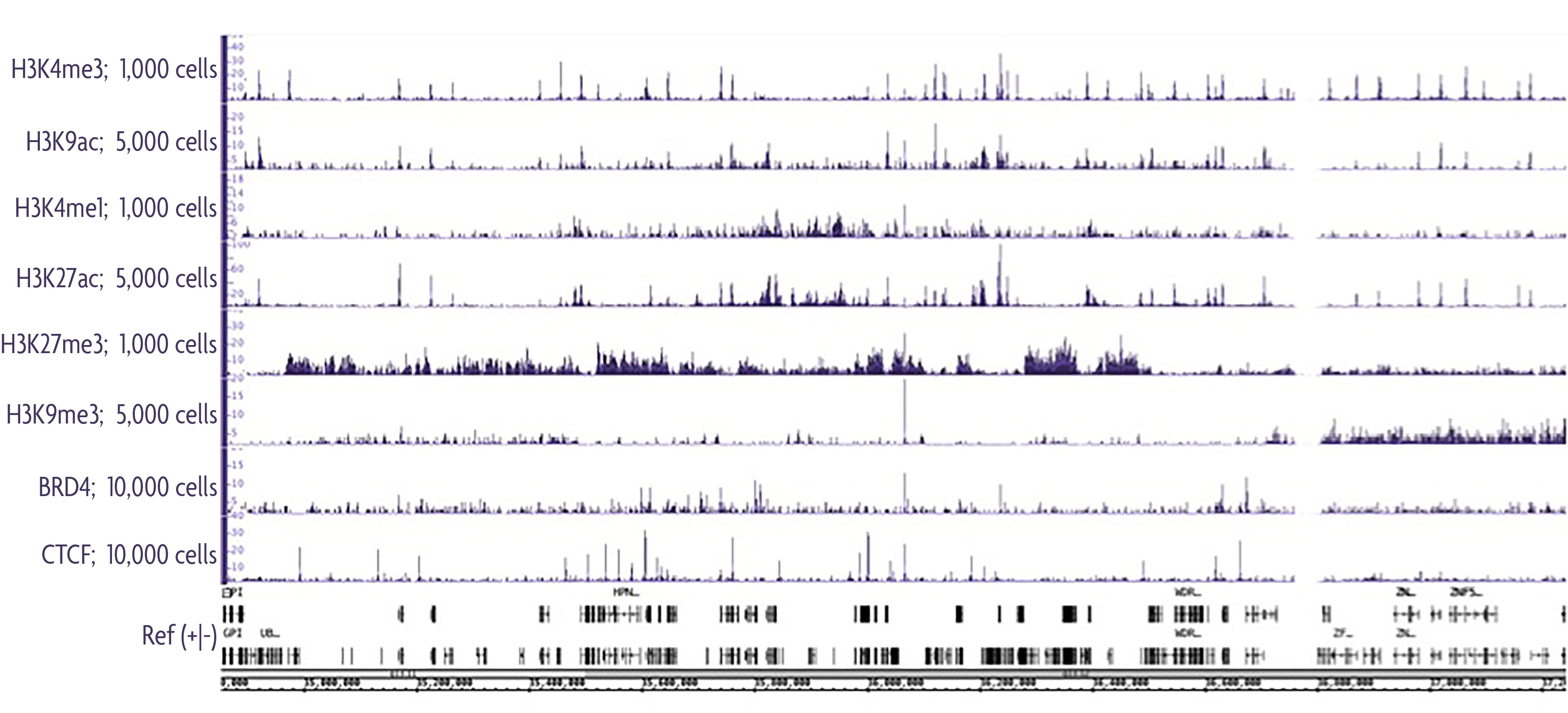
Figure 2: Summary of various Low Cell ChIP Kit experiments targeting both histone and low abundance proteins.
Low Cell ChIP Documents
Recommended Products and Services
You might also be interested in:
| Name | Format | Cat No. | Price | |
|---|---|---|---|---|
| Low Cell ChIP Kit | 16 rxns | 53086 | ¥10,270 | Add to Cart |
| ChIP Buffer | 50 ml | 37516 | ¥1,760 | Add to Cart |
| Blocking Reagent AM1 | 0.1 ml | 37496 | ¥1,760 | Add to Cart |
| BSA (10 mg/ml) | 0.1 ml | 37497 | ¥1,760 | Add to Cart |
| Blocker | 0.1 ml | 37498 | ¥1,760 | Add to Cart |
| Protein G Agarose Beads | 1.2 ml | 37499 | ¥2,670 | Add to Cart |
| TE, pH 8.0 | 35 ml | 37515 | ¥1,760 | Add to Cart |

